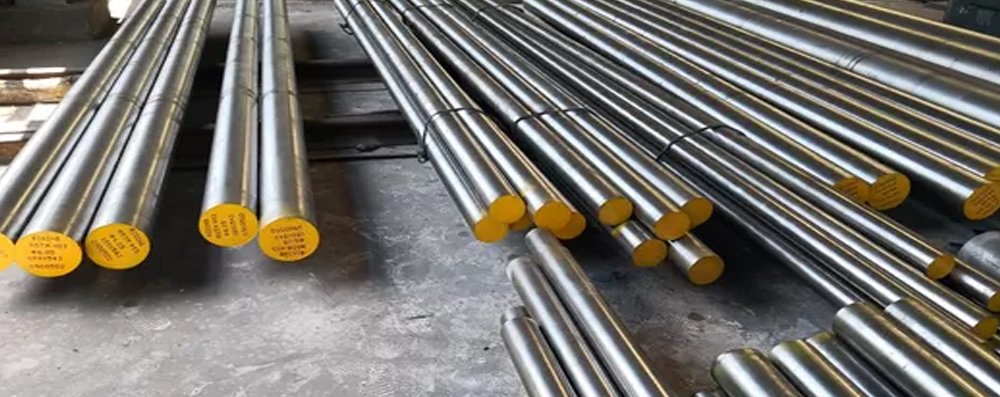Introduction
OHNS (O1) tool steel, also known as Oil Hardening Non-Shrinking steel, is a high-carbon tool steel alloy that offers good machinability and wear resistance. It is widely used for applications that require hardening by oil quenching, making it ideal for manufacturing dies, cutting tools, and punches. OHNS steel offers superior hardness and strength after heat treatment, while maintaining good dimensional stability during the hardening process.
O1 is often preferred for tools where high wear resistance and toughness are necessary, especially in cold work applications. It is widely used in the production of small and medium-sized components that require high hardness, like machine parts, tools, and dies.
Uses/Applications:
OHNS (O1) tool steel is used in various industrial applications where hardening by oil quenching is required. Common uses include:
Cutting Tools:
- Blades and knives
- Thread cutting tools
- Chisels and punches
- Drill bits and taps
Dies:
- Molds for plastic and rubber
- Dies for extrusion and forming
- Blanking and punching tools
- Cold work dies
Machine Components:
- Gears and shafts
- Bearings
- Wear-resistant parts
Cold Working Tools:
- Riveting tools
- Shears
- Scrapers
- Guillotine blades
Its versatility in tool making and machining applications makes it highly sought after in industries such as automotive, aerospace, and heavy machinery.
Properties of the Grade:
- High Wear Resistance
- Excellent Hardenability
- Good Dimensional Stability
- Good Toughness and Strength
- Moderate Corrosion Resistance
- Easy to Machine in the Annealed Condition
- Good Surface Finish After Heat Treatment
- Good Wear Resistance to Abrasion
Heat Treatment:
Annealing:
- Heat to 850°C – 900°C.
- Hold for 1 – 2 hours.
- Cool slowly in the furnace to room temperature for optimal ductility and machinability.
Hardening:
- Preheat to 800°C – 850°C.
- Heat to 800°C – 850°C for austenitizing.
- Quench in oil for optimal hardness and wear resistance.
Tempering:
- Temper at 150°C – 200°C to improve toughness.
- Double or triple tempering is recommended.
- Typical tempering temperature: 500°C – 550°C.
Chemical Composition:
| Element | Content (%) |
| Carbon (C) | 0.90 – 1.05 |
| Chromium (Cr) | 0.30 – 0.60 |
| Manganese (Mn) | 0.30 – 0.50 |
| Silicon (Si) | 0.30 – 0.50 |
| Vanadium (V) | 0.10 – 0.30 |
| Phosphorus (P) | ≤ 0.03 |
| Sulfur (S) | ≤ 0.03 |
The composition of OHNS (O1) tool steel ensures its high wear resistance, good hardness, and adequate toughness. The chromium content helps in enhancing its hardenability, while manganese and silicon contribute to its overall strength and toughness.
Mechanical Properties:
| Property | Typical Value |
| Hardness (Annealed) | ~ 207 HB |
| Hardness (Hardened) | 58 – 64 HRC |
| Tensile Strength | ~ 1400 MPa |
| Yield Strength | ~ 1050 MPa |
| Impact Toughness (Charpy V-notch) | Moderate |
| Compressive Strength | Excellent at elevated temperatures |
OHNS (O1) tool steel demonstrates superior hardness and wear resistance after heat treatment, making it suitable for cold work tools and dies.
Physical Properties:
| Property | Typical Value |
| Density | 7.85 g/cm³ |
| Modulus of Elasticity (E) | ~205 GPa |
| Thermal Conductivity | ~45 W/m·K at 200°C |
| Specific Heat Capacity | ~460 J/kg·K |
| Coefficient of Thermal Expansion | ~12.5 × 10⁻⁶ /°C |
Forging:
Forging Temperature Range: 850°C – 1050°C
Procedure:
- Preheat to 700°C – 800°C.
- Forge at the proper temperature range.
- After forging, the material should be cooled slowly in the furnace to relieve stresses.
Forging should be done with caution to avoid overheating, which could affect the mechanical properties.
Dimensional Tolerances:
- OHNS (O1) steel is known for its excellent dimensional stability during the hardening process.
- The material can be ground to tight tolerances and has minimal distortion during heat treatment, which is ideal for precision tool-making.
Machinability:
- OHNS (O1) tool steel is easy to machine in the annealed condition, providing good surface finish when processed.
- It is recommended to use high-speed steel (HSS) or carbide tools.
- Cooling lubricants should be used to improve tool life and surface finish.
- Post-hardening machining can be performed using carbide tools, as it has good grindability.
Corrosion Resistance:
Moderate Corrosion Resistance:
- OHNS (O1) tool steel does not have high corrosion resistance when compared to stainless steel grades.
- For increased corrosion resistance, proper coating or surface treatment is recommended.
- Tools and parts made from OHNS should be oiled or coated to prevent rust and oxidation, particularly when stored in humid environments.
Weldability:
Fair Weldability:
- OHNS (O1) tool steel can be welded, but preheating to 300°C – 400°C and post-weld heat treatment are required to avoid cracking.
- Suitable welding techniques include gas metal arc welding (GMAW) or TIG welding, using appropriate filler metals.
- Post-weld tempering is recommended to relieve stresses and reduce hardness in the heat-affected zone.
Available Form:
OHNS (O1) tool steel is available in various forms, including:
- Round Bars
- Square Bars
- Flats and Plates
- Pre-hardened Tool Steel
- Precision Ground Bars
It is available in different sizes and lengths, often to specific customer requirements.
Conclusion:
OHNS (O1) tool steel is a versatile, high-performance material ideal for tools and dies requiring high wear resistance, hardness, and toughness. With its excellent dimensional stability during heat treatment, good machinability, and the ability to maintain high hardness even at elevated temperatures, OHNS is a popular choice for cold work applications. Its moderate corrosion resistance and fair weldability ensure that it can be used in a wide range of applications, making it a preferred choice for many industrial sectors, including automotive, aerospace, and general engineering.
Related Products : D2, DB6, DIN 1.2714, DIN 1.2080, DIN 1.2379, DIN 1.2343, DIN 1.2344, EN31, H11, H13, OHNS, HCHCR, M2, P20+S, P20, P20+Ni, K310, Maps


